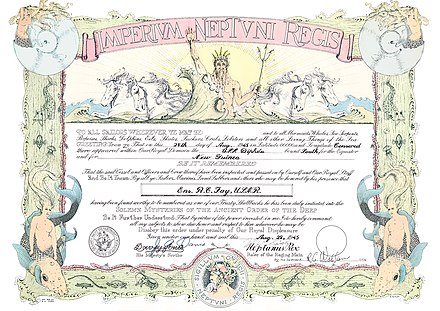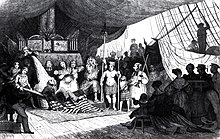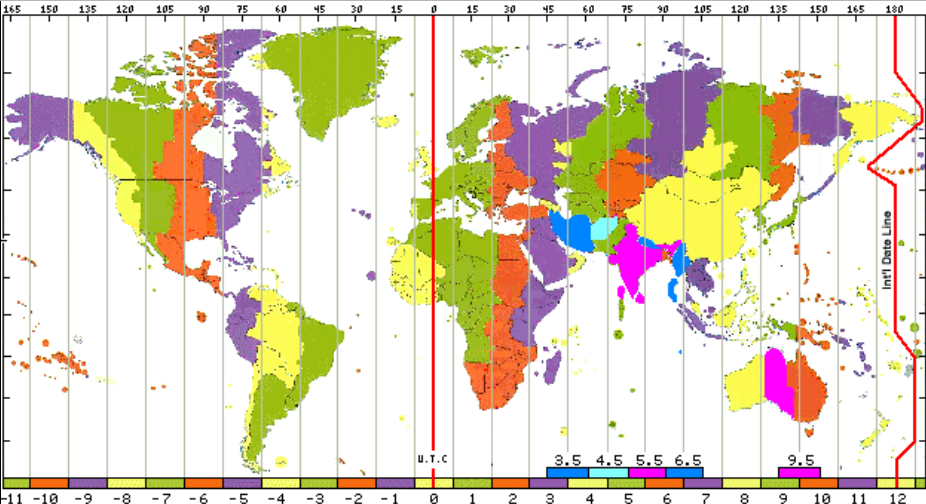
We covered the relationship between the Current Day Line Crossing Ceremonies and the Ancient Rituals in the first part of this series. In order to establish that this has been ongoing, we are going to cover just a little of the history of the ritual in our society. Also presented in this article is the information on the different crossing certificates and their significance. Most important is the video at the very bottom, please do not let the religious aspect of the video cause you to miss the important information in the message. Pay close attention to the specifics on the International Dateline and how it all ties in to Maritime/Rome/the US.
Behind the Strange and Controversial Ritual When You Cross the Equator At Sea
A sailor’s hazing-filled transition from a slimy pollywog to a trusty shellback during an equator line-crossing is a naval tradition unlike any other.
Ritualistic pain, immensely questionable sanitation and excessive humiliation have seemingly forever been a requirement of entering King Neptune’s royal court and becoming a son or daughter of the god of the sea.
The hazing festival, intended to be inescapable, traditionally allows no one the chance to be spared the prerequisite misery prior to joining the ancient order of the deep.
Line-crossing ceremony aboard Méduse on the first of July 1816.
Captain Robert FitzRoy of HMS Beagle suggested the practice had developed from earlier ceremonies in Spanish, Portuguese, and Italian vessels passing notable headlands. He thought it was beneficial to morale. FitzRoy quoted Otto von Kotzebue‘s 1830 description in his 1839 Narrative of the surveying voyages of His Majesty’s Ships Adventure and Beagle between the years 1826 and 1836.[2][8]
There is a detailed account of the ceremony on board HMS Blossom in 1825 by Petty Officer John Bechervaise in his private publication Thirty-Six Years of a Sea Faring Life (1839), available from Kessinger in facsimile. Blossom was just starting a three-year voyage of exploration around the Horn to the Arctic.[9]
A similar ceremony took place during the second survey voyage of HMS Beagle. As they approached the equator on the evening of 16 February 1832, a pseudo-Neptune hailed the ship. Those credulous enough to run forward to see Neptune “were received with the watery honors which it is customary to bestow”.[2] The officer on watch reported a boat ahead, and Captain FitzRoy ordered: “hands up, shorten sail”. Using a speaking trumpet he questioned Neptune, who would visit them the next morning. About 9 am the next day, the novices or “griffins” were assembled in the darkness and heat of the lower deck, then one at a time were blindfolded and led up on deck by “four of Neptune’s constables”, as “buckets of water were thundered all around”. The first “Griffin” was Charles Darwin, who noted in his diary how he “was then placed on a plank, which could be easily tilted up into a large bath of water. — They then lathered my face & mouth with pitch and paint, & scraped some of it off with a piece of roughened iron hoop. —a signal being given I was tilted head over heels into the water, where two men received me & dunked me. —at last, glad enough, I escaped. — most of the others were treated much worse, dirty mixtures being put in their mouths & rubbed on their faces. — The whole ship was a shower bath: & water was flying about in every direction: of course not one person, even the Captain, got clear of being wet through.” The ship’s artist, Augustus Earle, made a sketch of the scene.[3] Said Drawing is shown below.

Charles Darwin, the Lewis Carroll Forum
On the open sea, even the leader of a great nation must answer to King Neptune. Even President Franklin D. Roosevelt, who was aboard the USS Indianapolis when it crossed the equator in 1936, was not exempt from at least some form of embarrassment.
In 1936, President Franklin D. Roosevelt, too, received a summons to appear before the sea god and pay his respects. The charges brought against him:
- Disregard of the traditions of the sea.
- Taking liberties with the piscatorial subjects of His Majesty Neptunus Rex.
“You will accept most heartily and with good grace the pains and penalties of the awful torture that will be inflicted upon you to determine your fitness to be one of our Trusty Shellbacks,” the president’s summons read.
U.S. President Franklin D. Roosevelt described his crossing-the-line ceremony aboard the “Happy Ship” USS Indianapolis with his “Jolly Companions” in a letter to his wife Eleanor Roosevelt on 26 November 1936.[10] Later, during World War II, the frequency of the ceremony increased dramatically, especially in the United States Navy in the Pacific, where the service’s fleet operations grew enormously to counter widely dispersed Japanese forces.[11]
California Maritime Academy observed the line-crossing ceremony until 1989, after which the ceremony was deemed to be hazing and was forbidden. The 1989 crossing was fairly typical, as it was not realized to be the last one. Pollywogs participated voluntarily, though women midshipmen observed that they were under social pressure to do the ceremony but were targets of harder abuse.[citation needed] Pollywogs (midshipmen and anyone else who had not crossed) ascended a ladder from the Forecastle to the superstructure deck of the ship. There, they crawled down a gauntlet of shellbacks on both sides of a long, heavy canvas runner, about 10–12 meters. The shellbacks had prepared 3-foot, or 1-meter, lengths of canvas/rubber firehose, which they swung hard at the posterior of each wog. The wogs then ascended a ladder to the boat deck to slide down a makeshift chute into the baptism of messdeck leavings in seawater in an inflated liferaft back on the superstructure deck. Wogs then returned to the forecastle, where they were hosed off by firehose and then allowed to kiss, in turn, the belly of the sea-baby, the foot of the sea-hag, and the ring of King Neptune, each personified by shellbacks.[citation needed]
In 1995, a notorious line-crossing ceremony took place on a Royal Australian Navy submarine, HMAS Onslow. Sailors undergoing the ceremony were physically and verbally abused before being subjected to an act called “sump on the rump”, where a dark liquid was daubed over each sailor’s anus and genitalia. One sailor was then sexually assaulted with a long stick before all sailors undergoing the ceremony were forced to jump overboard until permitted to climb back aboard the submarine. A videotape of the ceremony was obtained by the Nine Network and aired on Australian television. The television coverage provoked widespread criticism, especially when the videotape showed some of the submarine’s officers watching the entire proceedings from the conning tower.[12][13]
Most navies have since then instituted regulations that prohibit physical attacks on sailors undergoing the line-crossing ceremony. In modern times, rather than a rite of initiation, the line-crossing ceremony has become a popular tradition in the U.S. Navy and the U.S. Coast Guard. In the PBS documentary Carrier filmed in 2005 (Episode 7, “Rites of Passage”), a crossing-the-line ceremony on the USS Nimitz was extensively documented. The ceremony is carefully orchestrated by the ship’s officers, with some sailors reporting the events to be lackluster due to the removal of the rites of initiation.
Controversy
USS Blue Ridge (LCC-19)“Whipping Time”. Steaming to Rio de Janeiro on 26 February 1971.
USS Blue Ridge (LCC-19) “Snacktime.” Steaming from Singapore on 29 August 1973.
In the 19th century and earlier, the line-crossing ceremony was quite a brutal event, often involving beating pollywogs with boards and wet ropes and sometimes throwing the victims over the side of the ship, dragging the pollywog in the surf from the stern. In more than one instance, sailors were reported to have been killed while participating in a line-crossing ceremony.
As late as World War II, the line-crossing ceremony was still rather rough and involved activities such as the “Devil’s Tongue”, which was an electrified piece of metal poked into the sides of those deemed pollywogs. Beatings were often still common, usually with wet firehoses, and several World War II Navy deck logs speak of sailors visiting sick bay after crossing the line.
Efforts to curtail the line-crossing ceremony did not begin until the 1980s, when several reports of blatant hazing began to circulate regarding the line-crossing ceremony, and at least one death was attributed to abuse while crossing the line.[citation needed]
In 2010, a Line Crossing Ceremony was an international affair. Sailors and Marines from the United States, Mexico, Argentina, Brazil, Columbia, Peru, and Uruguay crossed the equator together aboard the USS New Orleans.
“We have the same sort of ceremony in my country,” said Lt. j.g. Juan Pablo Rosato of the Argentine navy. “It is interesting to see how similar our maritime cultures are to one another. I think that being able to participate in the rite of passage with another friendly navy is always an honor and it allows us to know each other better.”
Equatorial baptism
Baptism on the line, also called equatorial baptism, is an initiation ritual sometimes performed as a ship crosses the Equator, involving water baptism of passengers or crew who have never crossed the Equator before.[14] The ceremony is sometimes explained as being an initiation into the court of King Neptune.
The ritual is the subject of a painting by Matthew Benedict named The Mariner’s Baptism and of a 1961 book by Henning Henningsen named Crossing the Equator: Sailor’s Baptism and Other Initiation Rites.[15]
[edit]
As Shellback initiation is conducted by each individual ship as a morale exercise and not officially recognized by the Navy with inclusion on discharge papers, DD Form 214, or through a formally organized institution, variations of the names as well as the protocol involved in induction vary from ship to ship and service to service.[16]
Unique Shellback designations have been given to special circumstances such as the Star Spangled Shellbacks being given to the crew of the USS Franklin D. Roosevelt (CVA-42) crossing the equator on July 4, 1966. It is not known if this designation has ever been used before or again as no other mention of such honor has to date been located.
Variations to the Shellback designation include:
- The Order of the Ebony Shellback for maritime personnel who have crossed the Equator on Lake Victoria.
- The Emerald Shellback or Royal Diamond Shellback for maritime personnel who cross the Equator at the prime meridian.
- The Golden Shellback for maritime personnel who have crossed the point where the Equator crosses the International Date Line.
- Diamond Shellback (Admiral Shellback) for crossing the Prime Meridian
International Date Line From Wikipedia, the free encyclopedia
 The simplified illustration (on the left) of the relation between date line, date and time of day. Each color represents a different date.
The simplified illustration (on the left) of the relation between date line, date and time of day. Each color represents a different date.The International Date Line around the antimeridian (180° longitude)
The International Date Line (IDL) is an imaginary line of demarcation on the surface of Earth that runs from the North Pole to the South Pole and demarcates the change of one calendar day to the next. It passes through the middle of the Pacific Ocean, roughly following the 180° line of longitude but deviating to pass around some territories and island groups.
- The Top Secret Shellback are for submariners who have crossed the equator at a classified degree of longitude.

“Imperial Domain of Golden Dragon” card given to Graham S. Fulghum aboard the USS Manatee(AO-58), marking his first crossing of the International Date Line, 11 June 1944.
180th meridianFrom Wikipedia, the free encyclopedia
The 180th meridian or antimeridian[1] is the meridian 180° both east and west of the Prime Meridian, with which it forms a great circle dividing the earth into the Western and Eastern Hemispheres. It is common to both east longitude and west longitude. It mostly passes through the open waters of the Pacific Ocean, but passes across land in Russia, Fiji, and Antarctica. This meridian is used as the basis for the International Date Line, but the latter deviates from it to maintain date consistency within the territories of Russia, USA, Kiribati, Fiji, and New Zealand.
Drawn up in 1884 – The 180° meridian was selected as the International Date Line because it mostly runs through the sparsely populated Central Pacific Ocean. It was decided at the International Meridian Conference in 1884 in Washington, D.C. where 26 countries attended.
Consequently, similar “fraternities” commemorating other significant milestones in one’s career include[17]:
- The Order of the Blue Nose (Domain of the Polar Bear) for maritime personnel who have crossed the Arctic Circle.
- The Caterpillar Club for aviators who had made an unscheduled parachute jump from a disabled plane.
- The Century Club for aviators who have completed their 100th carrier landing.
- The Realm of the Czars for maritime personnel who crossed into the Black Sea.
- The Order of the Ditch for maritime personnel who have passed through the Panama Canal.
- The Domain of the Golden Dragon for maritime personnel who have crossed the International Date Line.
- The Order of the Lakes for maritime personnel who have sailed on all five Great Lakes.
- The Order of Magellan for maritime personnel who circumnavigated the Earth.

Shellback certificate for Bob Fay aboard USS Diphda (AKA-59) for crossing the Equator in the Pacific at the end of World War II, August 1945.
- The Magellan’s Strait Jacket Club for all maritime personnel who transited the Straits of Magellan.
- The Moss Back are personnel who have sailed around the tip of South America.
- The Order of the Golden Oscar for maritime personnel who have served with the Entertainment Liaison Office.
- Persian Excursion – The Society of the Arabian Nights for maritime personnel who have served in the Persian Gulf.
- Plank owner for personnel stationed to a ship or shore command when that ship or unit was created, placed in commission, or in some cases removed from commission.
- The Order of Purple Porpoises for maritime personnel who crossed the junction of the Equator and the International Date Line at the Sacred Hour of the Vernal Equinox.[18]
- The Order of the Red Nose (Domain of the Penguin) for maritime personnel who have crossed the Antarctic Circle.
- The Order of the Rock for maritime personnel who have transited the Strait of Gibraltar.
- The Safari to Suez for maritime personnel who have passed through the Suez Canal.
- The Order of the Sand Squid (or Sand Sailor) for maritime personnel who have been attached to land-based Army or Marine units stationed in the Middle East.
- The Order of the Spanish Main for maritime personnel who have sailed in the Caribbean.
- The Order of the Sparrow for maritime personnel who sailed on all 7 seas.
- The Order of the Square Rigger for maritime personnel who have served aboard the USCGC Eagle or USS
THE UNITED STATES/INTERNATIONAL DATELINE
ROMAN CATHOLIC CHURCH
The Roman Catholic Church already responsible for changing the Sabbath. Rome also being responsible for the development of the Julian Calendar. Now responsible for establishing the International Dateline changing time for ALL nations.
The Image of the Beast is already here!





